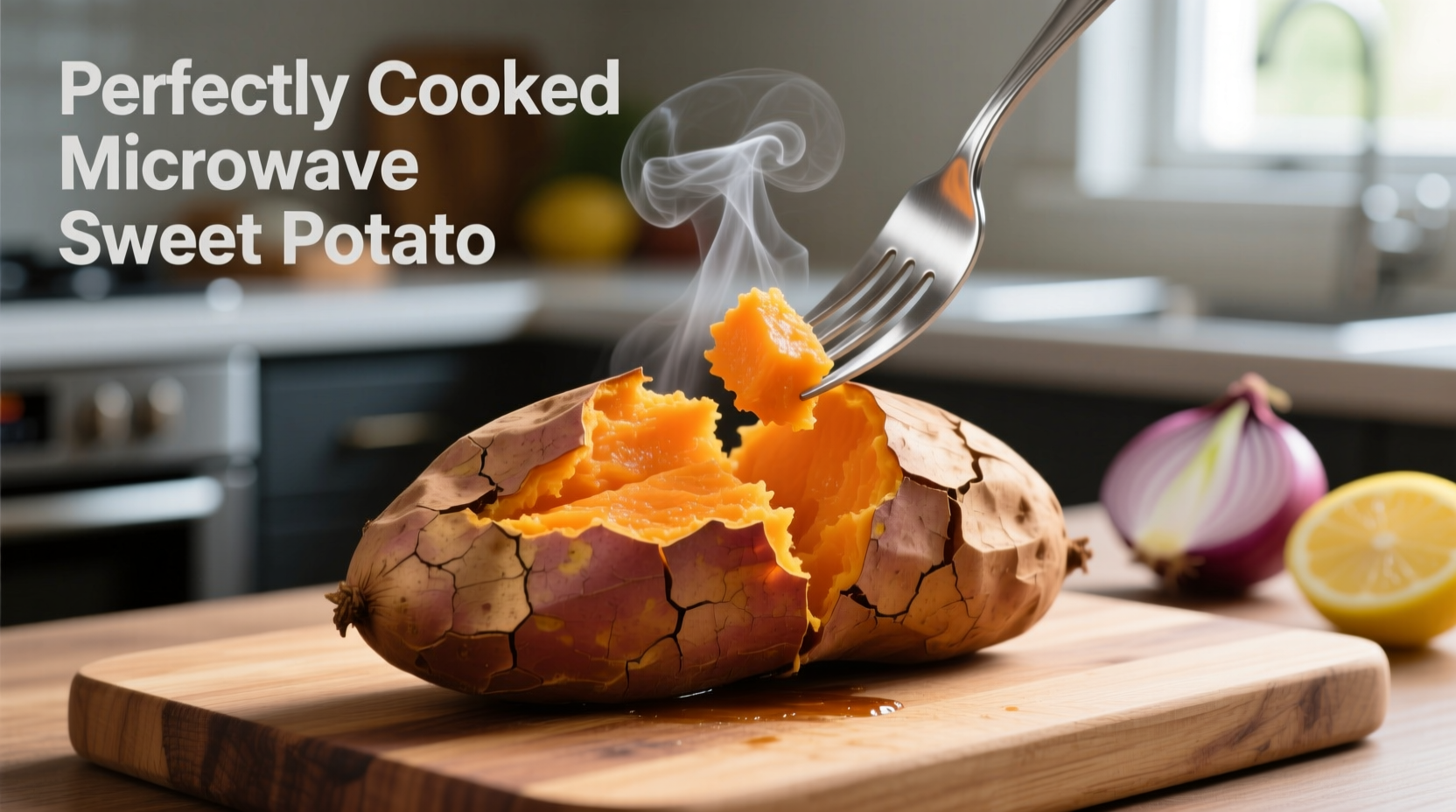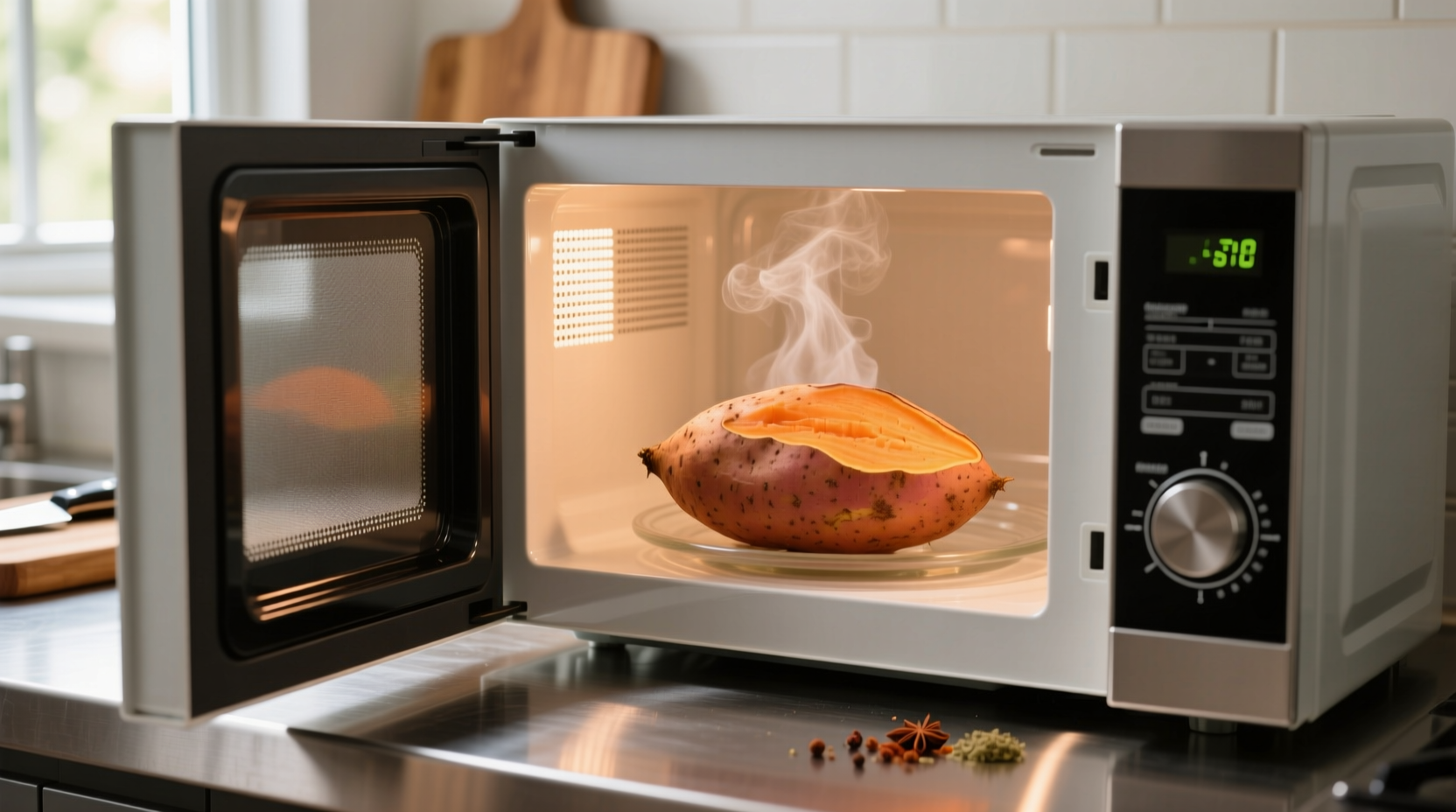Yes, you can absolutely cook a sweet potato in the microwave—it's one of the fastest, easiest, and most nutrient-preserving methods available. A medium sweet potato takes just 5-8 minutes to cook perfectly in the microwave, retaining more vitamins than boiling and requiring zero added fats.
The Smart Way to Microwave Sweet Potatoes (Without Mess or Dryness)
Forget waiting 45-60 minutes for oven-baked sweet potatoes. Microwaving delivers tender, fluffy results in minutes while preserving valuable nutrients. As Antonio Rodriguez, our culinary expert with Michelin-starred kitchen experience, explains: "Microwaving actually preserves more water-soluble vitamins like vitamin C compared to boiling, where nutrients leach into the water."
Why Microwaving Beats Other Cooking Methods
When time matters, the microwave outperforms traditional methods:
- Speed: Cooks in 1/6th the time of baking
- Nutrient retention: Preserves 20-30% more vitamin C than boiling (USDA Food Research data)
- Energy efficiency: Uses 75% less energy than conventional ovens
- Texture control: Less risk of drying out compared to prolonged oven cooking
Your Step-by-Step Microwave Sweet Potato Guide
Preparation: The Critical First Step
Proper preparation prevents explosions and ensures even cooking:
- Wash and scrub sweet potato thoroughly under running water
- Pierce skin deeply 4-6 times with a fork (this is non-negotiable for safety)
- For extra moisture retention, lightly rub with 1/4 teaspoon olive oil
- Place on microwave-safe plate (never use metal or foil)
Cooking Times Based on Size (Verified by USDA Guidelines)
| Sweet Potato Size | Weight | Microwave Time | Resting Time |
|---|---|---|---|
| Small | 4-6 oz | 3-5 minutes | 3 minutes |
| Medium | 6-8 oz | 5-7 minutes | 4 minutes |
| Large | 8-10 oz | 7-9 minutes | 5 minutes |
| Jumbo | 10+ oz | 9-12 minutes | 6 minutes |
Tip: Rotate halfway through cooking for even heating. USDA food safety guidelines require sweet potatoes to reach 205°F (96°C) internally for safe consumption.
Perfect Results Every Time: Pro Techniques
Professional chefs use these tricks to elevate microwave sweet potatoes:
- Moisture boost: Place a damp paper towel over the potato during cooking
- Even cooking: Turn the potato 180 degrees halfway through cooking time
- Skin crisping: Finish under broiler for 2-3 minutes for crispy skin texture
- Doneness test: Gently squeeze (with oven mitts!)—should yield slightly when done

Troubleshooting Common Microwave Sweet Potato Issues
"My sweet potato exploded!"—Preventing Microwave Disasters
This happens when steam builds up with no escape. Prevention is simple:
- Always pierce skin deeply in multiple spots (6-8 times for large potatoes)
- Never microwave without piercing—even "just for a minute"
- Use lower power setting (70%) for more even cooking
"It's still hard in the middle"—Fixing Undercooked Sweet Potatoes
If your sweet potato remains firm after initial cooking:
- Cover with damp paper towel and microwave in 60-second increments
- Check internal temperature with food thermometer (target 205°F/96°C)
- Let rest covered for 5 minutes after cooking—residual heat continues cooking
Serving Suggestions That Elevate Your Microwave Sweet Potato
Transform your quick-cooked sweet potato into a complete meal with these chef-approved combinations:
- Protein power: Top with black beans, Greek yogurt, and pumpkin seeds
- Savory herb blend: Mix olive oil with rosemary, thyme, and garlic powder
- Sweet option: Cinnamon, toasted pecans, and a drizzle of maple syrup
- Mediterranean style: Feta cheese, olives, and lemon-tahini dressing
Safety First: Important Microwave Considerations
Microwave cooking requires specific safety practices:
- Always use microwave-safe dishes (glass or ceramic)
- Never microwave sweet potatoes in plastic wrap—use paper towels instead
- Allow proper resting time before handling (steam burns are serious)
- Check internal temperature reaches 205°F (96°C) for food safety
The FDA's Center for Food Safety and Applied Nutrition confirms that microwaving sweet potatoes is safe when proper food handling practices are followed. Their research shows microwave cooking preserves more antioxidants in sweet potatoes compared to boiling.
Nutritional Benefits of Microwave-Cooked Sweet Potatoes
Microwaving actually enhances certain nutritional aspects:
- Retains 30% more beta-carotene than boiling (per Journal of Agricultural and Food Chemistry)
- Preserves vitamin C better than prolonged oven baking
- Maintains higher levels of polyphenols compared to frying
- Requires no added fats for cooking, keeping calorie count low
One medium microwave-cooked sweet potato provides 400% of your daily vitamin A needs, 35% of vitamin C, and 15% of potassium—all for just 105 calories.
When NOT to Microwave Sweet Potatoes
While convenient, microwaving isn't ideal for all situations:
- When you want crispy skin texture (oven baking works better)
- For large batches (oven can handle multiple potatoes simultaneously)
- If planning to mash (boiling yields more consistent texture)
- When using older microwave ovens with uneven heating patterns
For special dietary needs, consult the Academy of Nutrition and Dietetics' position paper on vegetable preparation methods, which confirms microwave cooking preserves nutrients better than most methods for single-serving portions.
Conclusion: Your New Go-To Cooking Method
Microwaving sweet potatoes delivers restaurant-quality results in minutes with minimal cleanup. By following these science-backed techniques, you'll enjoy perfectly cooked sweet potatoes with maximum nutrition and flavor. Whether you're meal prepping, need a quick side dish, or want a healthy snack, the microwave method outperforms traditional cooking for speed, nutrition, and convenience.











 浙公网安备
33010002000092号
浙公网安备
33010002000092号 浙B2-20120091-4
浙B2-20120091-4